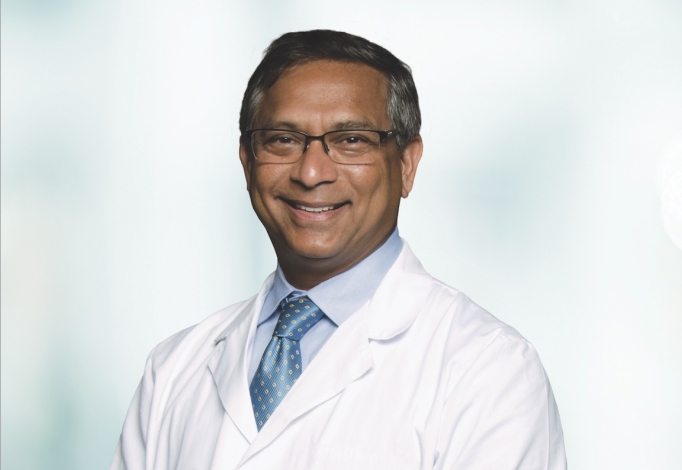Spinal Stenosis Could Be The Cause of Your Back Pain

Dr. Rakesh Chokshi, Spine Surgeon at McLeod Spine Center
Spinal stenosis occurs when the space around your spinal cord becomes too narrow, causing your spinal cord and nerves to become irritated, compressed, or pinched. This leads to back pain or pressure. The pain or pressure comes from a herniated disk and bone spurs which alters the space that the nerves travel through. The process happens over many months to years and is most often seen in the neck and lower back. Spinal stenosis can also be caused by an injury, a trauma, or the aging process of the spine.
The spinal cord, which runs through the spinal canal, is made up of spinal nerves that conduct signals from your brain to the rest of your body. The nerves are usually protected by the surrounding bone and disk structures. If the spinal nerves are damaged or impaired, functions such as walking, balance, and sensation become difficult, with symptoms worsening over time. However, some people with spinal stenosis have no symptoms at all.
Symptoms of Spinal Stenosis include:
- Pain
- Numbness
- Tingling or weakness in the arms, legs, or while walking
- Inability to walk the same distance as before and having to sit for a few minutes before walking again.
If symptoms are present, they can vary depending on which part of the spine is affected. Spinal stenosis in the lower back can cause pain or cramping in one or both legs. This happens when you stand for a long time or when you walk. Symptoms get better when you bend forward or sit. Some people also experience significant back pain. Symptoms can also be in the form of bladder and bowel incontinence.
Spinal stenosis in the neck can cause:
- Numbness
- Tingling or weakness in the arm and hands
- Difficulty with walking and balance
- Neck pain
- Problems with using hands
There are non-surgical and surgical treatment options for spinal stenosis. Depending on the cause, location, and severity of your symptoms, your provider may recommend treating symptoms at home, with physical therapy, medication, spinal injections to help manage the pain, or spinal surgery.
Treating symptoms at home may include applying heat or ice packs to the area. By applying heat, you are helping increase blood flow, relax muscles, and relieve achy joints. Make sure to use caution when using heat. Too high of a heat setting can cause burns. When using ice or cold gel packs, make sure to alternate 20 minutes on and 20 minutes off. This helps reduce swelling, tenderness, and inflammation.
Exercise is another way to help alleviate pain by strengthening the muscles that support your spine and improving your flexibility and balance. Always check with your primary care provider before introducing any exercise routine.
If physical therapy is prescribed, a physical therapist will develop a back-healthy exercise program specifically tailored to you. This program would include workout routines to help strengthen your back and abdominal muscles, which help improve your flexibility and spine stability.
Spinal corticosteroid injections may also be prescribed to help reduce inflammation, pain, and irritation in the space around the pinched spinal nerves.
If these treatment options do not provide relief, surgery may be recommended. Surgery can create more space inside the spine. By removing bone spurs, overgrown soft tissue, and/or a herniated disk, the spinal surgeon creates additional room for the spinal nerves. Your surgeon may discuss spinal fusion surgery to stabilize the spine. The surgeon does this by connecting two or more bones in the spine using bone or bonelike material in the space between two spinal bones. Metal plates, screws or rods may be used to help hold the bones together. This helps give the bones time to fuse and heal together as one bone.
There are certain lifestyle changes you can make to keep your spine healthy, helping to lower your risk and slow the progression of spinal stenosis. These changes include:
- Eating healthy foods and getting enough Calcium and Vitamin D in your diet to promote strong bones.
- Maintaining a healthy weight and exercising regularly
- Avoid smoking or quit smoking. Smoking is known to damage arteries, which can contribute to back pain and make it difficult for injuries to heal.
- Practice good posture
If you are experiencing symptoms of spinal stenosis, speak to your primary care provider about a referral to an Orthopedic Spine Surgeon.
McLeod Spine Surgeon, Dr. Rakesh Chokshi, cares for patients at McLeod Spine Center in Florence. Dr. Chokshi provides non-surgical as well as minimally invasive surgical options while utilizing the latest technology for the treatment of cervical (neck), thoracic (middle), and lumbar (lower) spine-related conditions.
-
McLEOD REGIONAL MEDICAL CENTER FLORENCE
843-777-2000 -
McLEOD DARLINGTON
843-777-1100 -
McLEOD DILLON
843-774-4111 -
McLEOD LORIS
843-716-7000 -
McLEOD SEACOAST
843-390-8100 -
McLEOD CHERAW
843-537-7881 -
McLEOD CLARENDON
803-433-3000



-
McLEOD REGIONAL MEDICAL CENTER FLORENCE
843-777-2000 -
McLEOD DARLINGTON
843-777-1100 -
McLEOD DILLON
843-774-4111 -
McLEOD LORIS
843-716-7000 -
McLEOD SEACOAST
843-390-8100 -
McLEOD CHERAW
843-537-7881 -
McLEOD CLARENDON
803-433-3000
 Find a Doctor
Find a Doctor  Locations
Locations  Services
Services